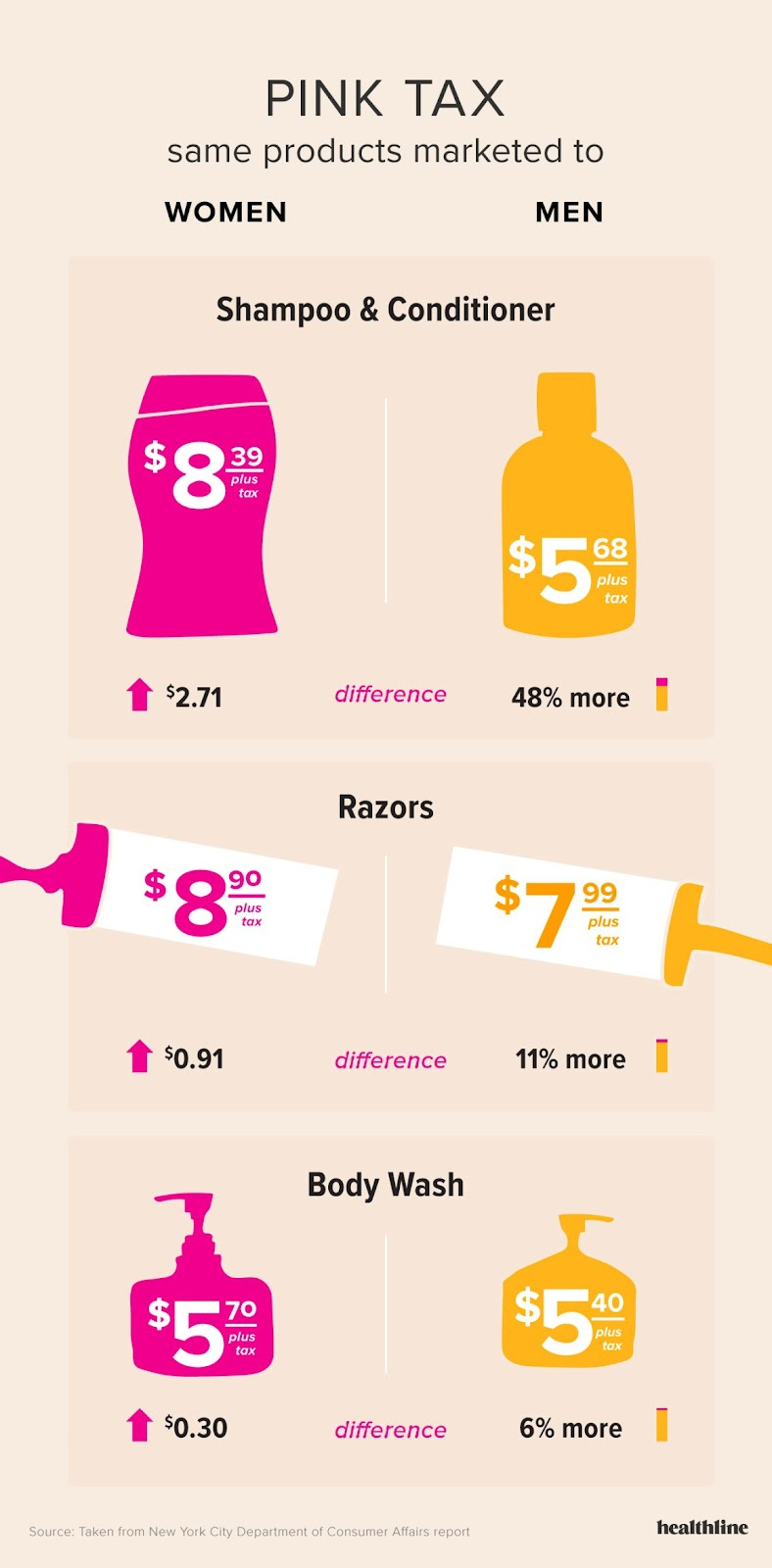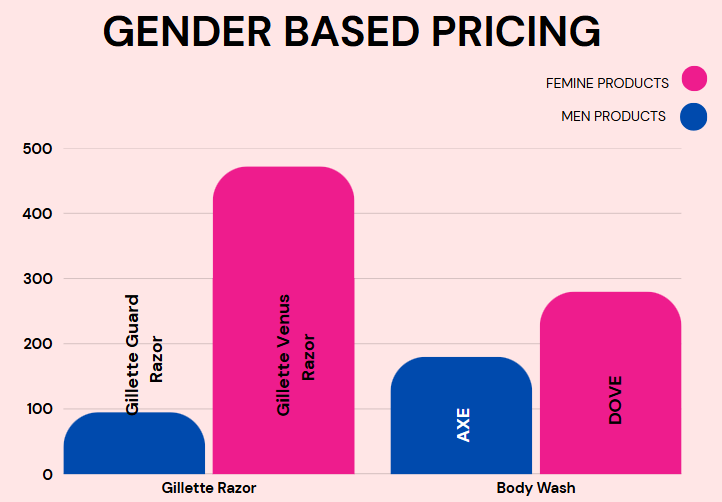Pink, Price and Prejudice
What Is Pink Tax?
Ever felt like you are paying extra just for existing as a woman? Turns out, you might be. Notice that certain products and services marketed to women often cost more than similar ones for men. Think razors, deodorants, or even dry cleaning. This is what is commonly called the Pink Tax. The result? Women end up paying more money for essentially similar items, piling onto the deeply entrenched gender inequalities in our society
The Psychology Behind
Why does this happen? Well, let’s talk about stereotypes. The term itself, Pink Tax, is based on the prejudice that many of the affected products for women are pink. However, the problem runs deeper. Women are subjected to high societal pressures when it comes to their appearance and psyche ever since their childhood. There is not much that goes by without society telling a woman how she should be. As a result, women tend to spend more on personal care and beauty products than men. If society tells you that a certain product is a must-have, brands know how to capitalize on it. And Voila! A market recipe for exploitation.
Price Discrepancies with a Pink Ribbon
Let's dive into how much of a difference this tax makes, for the same accessory but pink. After a heavy analysis of 794 products across 35 categories, by the New York City Department of Consumer Affairs, it was found that on average, products marketed to women cost 7% more than those for men. Personal care products have a 13% price hike for products bought by women. They know the weak spot because skincare is every woman’s day end friend, asking you about your day.
The Wage Equality Score Index, as used in the Global Gender Gap Report, measures wage parity between men and women on a scale from 0 to 1, where 1.0 indicates full equality (equal pay for equal work) and 0 means complete inequality (women earn nothing compared to men).The tax zoomed out globally where the report highlighted that out of 146 countries studied, only five indicated a wage equality score above 0.80 (relatively smaller wage disparities). If you've not gone nuts already, this wage gap paired with higher prices, means women are often paying more for less.
Suspects at Hand
From razors to dry cleaning, personal loans to healthcare, women pay this latent penalty in everyday purchases—often without even realizing it. The Pink Tax infiltrates multiple sectors, silently accumulating over a lifetime. While the impact varies across industries, some of the offenders caught red handed include:
Necessary Luxuries: Personal Care & Hygiene
Deodorants, shampoos, and skincare despite being essential come with a premium; costs 13% higher than their male-marketed counterparts with subtle differences in packaging but profound effect on pockets. This is not about some superior formulation but this disparity extends across wellness and beauty industries, because apparently women are expected to invest more in this colour-coded self-care.
The made-up Markup in Fashion Industry
Clothing, the most fundamental of all necessities, is a stellar example of how this gendered pricing pervades everyday life. Women’s apparel carries an average 8% markup compared to men’s, even if made with similar material and technique. Not just fast fashion, but formal wear and basic t-shirts are part of the arguments justifying the disparity around design complexity and production costs.
Service Sector Stake: From Grooming to Dry Cleaning
The Pink Tax is not limited to physical products; services like haircuts, dry cleaning, and alterations exhibit a surcharge of 25% to 50% more. Again, the labor, the skills required are just identical to that for men. Citing the complex designs, standard men’s dress shirts and women’s blouses frequently incur different cleaning costs, for the nth time, the same fabrics. This default pricing strategy results in a piled up wealth gap over time.
Extra Finance Cost: Loans, Credit, and Insurance
Women, on average, face higher interest rates on personal loans and credit cards, despite having similar or even better credit scores than men. A 2021 Financial Times study found that lenders subtly factor gender into risk assessments, citing industry-specific earning potential and career longevity. Ironically, even life and health insurance policies often impose higher premiums on women, compounding the financial burden all the way more.
Pricing in Kids' Products
The most horrific phase of this tax starts at early childhood. Toys and accessories marketed to girls cost, on average, 7% more than those designed for boys, even when functionally identical. A widely cited study found that a pink scooter was priced $25 higher than the same model in red. This puts an inexplicable burden on families and a lesson for girls put forth; that they expect higher costs and wider expenses as they grow.
Source: Healthline
The Savvy Shopper Era
People are catching on. Gender-based pricing is heavily criticised, from social media’s #AxThePinkTax to legal reforms, the activism is turning massive. As activism gains momentum, stakeholders, including policymakers, consumer rights groups, corporations etc., are being forced to take action.
Pink Tax in Action
Let's delve deeper into how the Pink Tax manifests in specific industries:
Healthcare: The "tampon tax" is the best example to show the anomaly of this revenue generation, where menstrual products are taxed as luxury items in various regions, despite being necessities. This led to the stakeholders calling for policy changes. Sanitary napkins were exempted from the 12% Goods and Services Tax (GST) in July 2018 following public opposition and advocacy efforts.
Retail: This particular section is full of filthy pricing systems, be it women's plus-size jeans costing more than men's, even when the products are similar. Dry-cleaning services for the same shirts may cost women as much as 92% more than men. Given the significance of the retail sector, the prevalence of the Pink Tax underscores the need for policy interventions to cool down this heated economic bias going on for a long time now.
Financial Products: Women may encounter higher premiums for financial services like long-term care insurance and annuities, often justified by longer life expectancies. A report by Niva Bupa highlights that women of childbearing age may face higher premiums due to increased healthcare utilization during reproductive years. However, as an exception, banks like SBI and HDFC provide a concession of 5 basis points (0.05%) on home loan interest rates for women borrowers to promote homeownership. Just one of those very few areas, where pricing supports women customers.
Economic Implications- The Price Of Being A Women
The Pink Tax has long imposed an economic burden on women. It depletes women’s incomes by increasing their everyday expenses, while many of them already earn less due to the established gender pay gap.The double attack of earning less and paying more for essentials creates a lose-lose situation- less disposable income, higher costs, and a wider financial gap. And as if this wasn’t sufficient, the Imposition of higher taxes on essential female hygiene products works in similar ways and reveals the true cost of being a woman.
Did You Know
In India, sanitary napkins were taxed at 12% under the GST regime while male contraceptives were termed “necessary” and exempted from tax. This inequitable taxation led to a nationwide campaign led by activists, organisations, and ordinary citizens under movements like #LahukaLagaan ( Tax On Blood). The campaign argued that menstruation is a biological necessity, not a luxury, and taxing period products worsened period poverty, particularly for low income women and rural populations. Finally in July 2018, this legislation was finally scrapped. While this was a major victory, it also revealed deep rooted gender bias in taxation policies
Brands Are Waking Up (Or At Least Trying to Look Woke)
The good news? Some brands are finally realizing that charging extra just because a product is pink is a terrible business strategy in the long run. The bad news? Not everyone’s on board yet, and some companies are just using it as a marketing gimmick.
Case Study: Gill-let her pay more!
Gillette, one of the most recognizable names in the shaving industry, has long been at the center of the Pink Tax debate. The brand, owned by Procter & Gamble (P&G), sells razors for both men and women.
What's bothering the activists?
Gillette's higher pricing to the feminine product even though its like a twin to one of what the men use, yes its the Gillett Venus v/s Gilletts Guard Manual. The Gillette Venus Razor with Aloe Extract & 2 Refills Combo is listed at ₹674, with a discounted price of ₹472 on the other hand The Gillette Guard Manual Shaving Razor Blades pack, which includes 6 cartridges and 1 razor, is available for ₹95, discounted from ₹125. The price hike is too much right? Even children aren’t spared the Pink Tax—products like backpacks, shoes, and toothbrushes often cost 10–20% more when marketed to girls. The only difference? A splash of pink and a sprinkle of stereotypes.
The excuse: it's all about the feature
As legitly claimed by the company, it is the extra features and care which is being charged higher. Sure, women's skin is softer than men's, but not this much that it costs the whole of men's bathing essentials! and that to when women themselves are unable to figure out any such advanced feature of difference between the two. Gillette must think of a new excuse!
But wait gillette also woke once!
Source:WEF Gender Gap Report 2022
Comeback!
After growing backlash, Gillette made some strategic moves:
Launched gender-neutral lines: They introduced Gillette SkinGuard, a razor marketed for sensitive skin (without gendered pricing).
Reduced the Price Gap: Some regions saw price adjustments in the Venus range, though differences still exist.
Marketing Shift: Instead of focusing solely on gendered aesthetics, they began emphasizing skin type and shaving needs, which better justifies product differentiation.
Other Early Wakers: Unsnoozed Squad
Billie (not the singer off course): This women’s razor company made waves by pricing their products fairly—no unnecessary “pink premium.” Their tagline? “A razor without the pink tax.” Now, if only the rest of the beauty industry could catch up. Similar is the case with AXE and Dove, different scents, different labels, but the price gap still smells fishy.
What’s Happening Within the World?
The U.S. has tried, but laws are inconsistent. New York banned gender-based pricing in 2020, but most states still allow it. The French government actively investigates and calls out companies guilty of gendered pricing. The UK’s lawmakers have debated bans on gendered pricing, but so far, it’s mostly pressure from consumer groups making the real impact.
And India?
In India, the Pink Tax is most evident in sanitary products, personal care, and even financial services. The GST on sanitary napkins was finally removed in 2018 (after much public outrage), but gendered pricing in other sectors still flies under the radar. Unlike Western countries, India lacks explicit laws against gender-based pricing, and consumer awareness is just beginning to pick. To combat the Pink Tax in India, we need clear laws against gender-based pricing, greater price transparency, and fair tax policies. Coupled with consumer awareness, regulatory oversight, and incentives for inclusive branding, these steps can level the playing field.
Digital Deception-The Pink Tax Goes Online
Online shopping and targeted advertising have only made things worse. Algorithms ensure that women see higher priced products through advertisements, making gendered pricing even harder to escape.Raging as it is, it clarifies how these businesses view women as easy targets who can be psychologically manipulated to buy expensive products.
The Way Forward?
Steps to curb the Pink tax are underway. In fact, the UN has called on countries worldwide to eliminate such practices. Some prominent solutions include gender-based tax rebates, HRA exemptions (since women often pay higher rent for safety), stronger regulations & consumer awareness and financial literacy programs to help women make informed spending choices.
Conclusion: Final Razor-Sharp Thoughts
Pink Tax? It’s that ‘just a little extra’ no one asked for—but everyone’s still paying, taking way more than expected—your money, patience, and faith in fair pricing. Sure, some companies are “waking up,” Meanwhile, some brands are slapping on a 'for sensitive skin' label like it’s a magic spell—and calling it innovation. Giving special treatment to women is good but making benefits out of it should be stopped. The Pink Tax isn’t just about razors and shampoos—it’s a reflection of a deeper economic bias that subtly drains women's wallets while industries play the “extra care” card.
References
LamprellE, & LamprellE. (2022, April 29). Pink Tax: The gender bias in product recommendations and corporate social responsibility - LSE Human Rights. LSE Human Rights - A student-led blog from LSE Human Rights. https://blogs.lse.ac.uk/humanrights/2022/04/29/pink-tax-the-gender-bias-in-product-recommendations-and-corporate-social-responsibility
https://blogs.lse.ac.uk/humanrights/2022/04/29/pink-tax-the-gender-bias-in-product-recommendations-and-corporate-social-responsibility
Binkley, C. (2024, December 5). ‘Pink tariffs’ plague US fashion. Vogue Business. https://www.voguebusiness.com/story/fashion/pink-tariffs-plague-us-fashion
Radonic, D., Djordjevic, N., & Djordjevic, N. (2023, February 10). 12+ pink tax statistics you should be aware of in 2023. Moneyzine. https://moneyzine.com/personal-finance/pink-tax-statistics/
Deloitte. (n.d.). Hiding in plain sight: The health care gender toll. In Deloitte. https://www2.deloitte.com/content/dam/Deloitte/us/Documents/life-sciences-health-care/us-lshc-health-gender-gap.pdf
Team, C. (n.d.). Education matters: Study of women’s health insurance links educational attainment to coverage. UCLA Center for Health Policy Research. https://healthpolicy.ucla.edu/newsroom/blog/education-matters-study-womens-health-insurance-links-educational-attainment-coverage?utm_source=chatgpt.com
Kaplan, S. (2021, March 22). Rethink pink: Elimination of pink tax by online retailer Boxed Gender and the Economy. Gender and the Economy. https://www.gendereconomy.org/boxed-elimination-of-pink-tax
Pink Tax- The additional cost of being a woman – GNLU Journal of Law & Economics. (2020, August 19). https://gjle.in/2020/08/19/pink-tax-the-additional-cost-of-being-a-woman/
Kulkarni, S. (2023, March 7). Home loan interest rate: How much concession do women borrowers get on home loan interest rates? Economic Times. https://m.economictimes.com/wealth/borrow/home-loan-interest-rate-how-much-concession-do-women-borrowers-get-on-home-loan-interest-rates/amp_articleshow/98476802.cms
Bupa, N. (2021, October 14). How does gender affect health insurance premiums in India? Niva Bupa. https://www.nivabupa.com/health-insurance-articles/how-does-gender-affect-health-insurance-premiums-in-india.html











